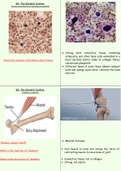B4: The Skeletal System
Structure and Function of Cartilage and ligaments
Strong hard connective tissue containing
osteocytes and other bone cells embedded in a
State any relevant information about bones hard calcified matrix made of collagen fibres,
calcium and phosphate
Different types of bone tissue (dense compact
bone and spongy bone which contains the bone
marrow)
B4: The Skeletal System
Tendons vs. Ligaments
Muscles to bones
Tendons connect what?
Join muscle to bone and convey the force of
What is the function of Tendons?
contracting muscle to move bone at joint
What is the structure of Tendons? Connective tissue rich in collagen
Strong, not elastic
, B4: The Skeletal System
Tendons vs. Ligaments
Ligaments connect what? Bones to bones
Hold bones together at joint, preventing
What is the function of Ligaments?
overstretching or dislocation
Yellow elastic connective tissue
What is the structure of Ligaments?
partly to hold the joint together but also to
prevent overstretching at the joint.
B4: The Skeletal System
The Classification of Joints
Junction between two different bones
What is the definition of joints?
Where bones meet and move against one
another
Give the three classifications of joints Fibrous, Cartilaginous and Synovial
*Most joints allow some form of movement
between bones (semi-moveable and moveable)
some are immoveable
, B4: The Skeletal System
Classification of Joints
Define Fibrous
which are fixed, meaning that they allow no
movement, for example between the bones of
the skull
Held together by fibres or cartilage
Immoveable – no movement between bones
Define Cartilagenous
cartilaginous joints, which allow little movement,
for example, the pubic symphysis
Held together / cushioned by cartilage
Limited movement between bones
, B2: The Skeletal System
Classification of Joints
Define Synovial
freely moveable synovial joints, which are the
commonest type of joint.
Cushioned by a membrane surrounding synovial
fluid, and with the end of bones protected by
cartilage and held together by ligaments
e.g: Rotation at a ball and socket joint
B4: The Skeletal System
Synovial Joint Structure
Synovial Joint Structure
Where two or more bones meet and move
against each other, their ends are
covered by a thin layer of smooth
cartilage which prevents friction.
There is a fibrous joint capsule enclosing
the joint and this is lined by a delicate
synovial membrane, which secretes a small
volume of synovial fluid that fills the
capsule and also prevents friction.
The joint capsule is reinforced at
intervals by ligaments, to prevent
overstretching.





